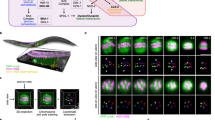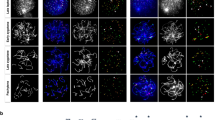Abstract
The spindle assembly checkpoint guards against chromosomal missegregation but does not induce arrest in oocytes that contain a few achiasmatic chromosomes (univalents). We followed the fate of univalents in oocytes during the first meiotic division, and although these preserved a meiotic kinetochore structure, they were also bi-oriented in a mitotic manner. The hybrid chromosomal configuration attained by univalents allows them to evade the spindle assembly checkpoint and contribute to aneuploidy in oocytes.
This is a preview of subscription content, access via your institution
Access options
Subscribe to this journal
Receive 12 print issues and online access
$209.00 per year
only $17.42 per issue
Buy this article
- Purchase on Springer Link
- Instant access to full article PDF
Prices may be subject to local taxes which are calculated during checkout


Similar content being viewed by others
References
Taylor, S.S., Scott, M.I. & Holland, A.J. Chromosome Res. 12, 599–616 (2004).
Brunet, S., Pahlavan, G., Taylor, S. & Maro, B. Reproduction 126, 443–450 (2003).
Homer, H.A. et al. Genes Dev. 19, 202–207 (2005).
Hauf, S. & Watanabe, Y. Cell 119, 317–327 (2004).
Page, S.L. & Hawley, R.S. Science 301, 785–789 (2003).
LeMaire-Adkins, R., Radke, K. & Hunt, P.A. J. Cell Biol. 139, 1611–1619 (1997).
Lightfoot, D.A., Kouznetsova, A., Mahdy, E., Wilbertz, J. & Hoog, C. Dev Biol. 289, 384–394 (2006).
Yuan, L. et al. Science 296, 1115–1118 (2002).
Kallio, M., Eriksson, J.E. & Gorbsky, G.J. Dev. Biol. 225, 112–123 (2000).
Woods, L.M. et al. J. Cell Biol. 145, 1395–1406 (1999).
Pinsky, B.A. & Biggins, S. Trends Cell Biol. 15, 486–493 (2005).
Ahonen, L.J. et al. Curr. Biol. 15, 1078–1089 (2005).
Vaur, S. et al. Curr. Biol. 15, 2263–2270 (2005).
Hassold, T. & Hunt, P. Nat. Rev. Genet. 2, 280–291 (2001).
Kuliev, A. & Verlinsky, Y. Hum. Reprod. Update 10, 401–407 (2004).
Acknowledgements
We are grateful to S. Sahlen for the introduction to the SKY technique, L. Ferguson for the help with the oocyte collection, G. Greggains for the support in data analysis and O. Shupliakov and N. Tomilin for the assistance in the electron microscopy field. This work was supported by grants from the Swedish Cancer Society, the Swedish Research Council, Karolinska Institutet and a grant from Birth Defects Foundation to M.H.
Author information
Authors and Affiliations
Contributions
A.K. and C.H. designed the experiments and wrote the manuscript. M.N. provided support with the SKY methodology. L.L., A.K. and M.H. performed the live cell imaging experiments.
Corresponding author
Ethics declarations
Competing interests
The authors declare no competing financial interests.
Supplementary information
Supplementary Text and Figures
Supplementary Figures 1–4, Supplementary Methods (PDF 1773 kb)
Supplementary Video 1
Chromosome dynamics at the first meiotic division for a wild-type oocyte. (MOV 1021 kb)
Supplementary Video 2
Chromosome dynamics at the first meiotic division for an Sycp3−/− oocyte. (MOV 486 kb)
Supplementary Video 3
3D reconstruction of the kinetochore region of a centrally positioned univalent. (MOV 770 kb)
Rights and permissions
About this article
Cite this article
Kouznetsova, A., Lister, L., Nordenskjöld, M. et al. Bi-orientation of achiasmatic chromosomes in meiosis I oocytes contributes to aneuploidy in mice. Nat Genet 39, 966–968 (2007). https://doi.org/10.1038/ng2065
Received:
Accepted:
Published:
Issue Date:
DOI: https://doi.org/10.1038/ng2065
This article is cited by
-
Meiotic spindle assembly checkpoint and aneuploidy in males versus females
Cellular and Molecular Life Sciences (2019)
-
Maternal obesity enhances oocyte chromosome abnormalities associated with aging
Chromosoma (2019)
-
Mps1 kinase-dependent Sgo2 centromere localisation mediates cohesin protection in mouse oocyte meiosis I
Nature Communications (2017)
-
The chromosomal basis of meiotic acentrosomal spindle assembly and function in oocytes
Chromosoma (2017)
-
How oocytes try to get it right: spindle checkpoint control in meiosis
Chromosoma (2016)



